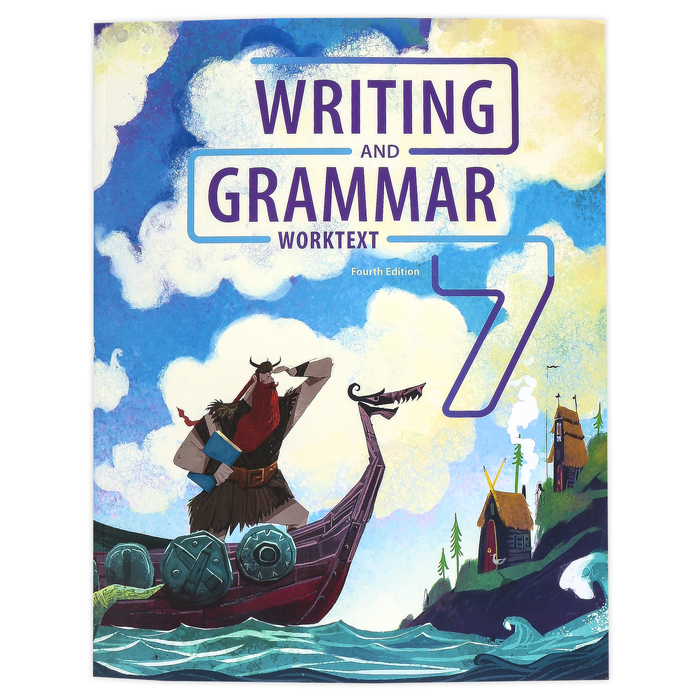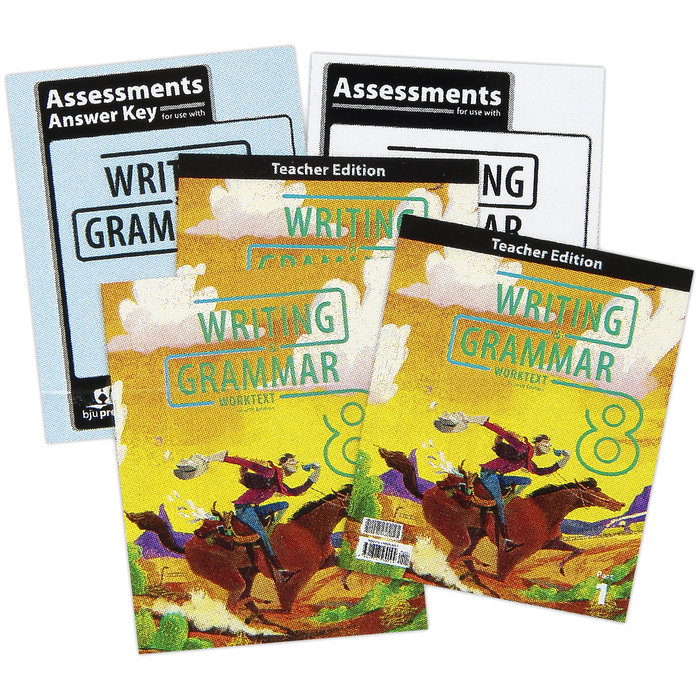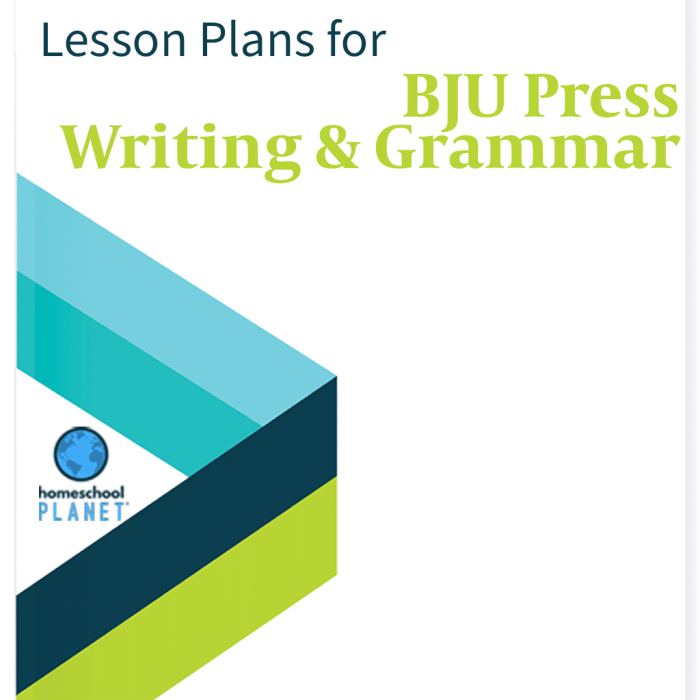BJU Writing and Grammar 7 takes center stage as we delve into the realm of effective writing and grammar. Get ready for an engaging journey where knowledge and creativity intertwine, promising an enriching and unforgettable learning experience.
This comprehensive curriculum empowers students with a solid foundation in grammar concepts, writing strategies, vocabulary building, and assessment techniques. Join us as we uncover the intricacies of BJU Writing and Grammar 7, equipping you with the skills to excel in written communication.
BJU Writing and Grammar 7 Overview

BJU Writing and Grammar 7 is a comprehensive curriculum designed to enhance students’ writing and grammar skills. It targets students in the seventh grade and aims to provide a strong foundation in the fundamentals of language arts.
The curriculum adopts a systematic and sequential approach, emphasizing the mastery of essential concepts before moving on to more advanced topics. It incorporates a variety of instructional methods, including direct instruction, guided practice, and independent application, to cater to diverse learning styles.
Structure and Organization
The BJU Writing and Grammar 7 textbook is divided into two main sections: writing and grammar. The writing section covers various aspects of writing, including grammar, punctuation, and sentence structure, while the grammar section focuses on the study of parts of speech, sentence structure, and usage.
Each lesson within the textbook follows a consistent structure. It begins with a clear statement of learning objectives, followed by an engaging introduction that captures students’ attention. The lesson then presents the new concept or skill, provides guided practice opportunities, and concludes with a review and assessment to reinforce learning.
The accompanying materials, such as a teacher’s manual, student workbook, and online resources, provide additional support for both teachers and students. The teacher’s manual offers detailed lesson plans, answer keys, and assessment tools, while the student workbook includes practice exercises and review activities.
Grammar Concepts and Skills

BJU Writing and Grammar 7 covers a comprehensive range of grammar concepts, equipping students with a solid foundation in the English language. These concepts are systematically introduced and reinforced through various teaching methods and exercises.
Parts of Speech
Students learn to identify and understand the different parts of speech, including nouns, verbs, adjectives, adverbs, pronouns, prepositions, conjunctions, and interjections. They explore the functions of each part of speech and practice using them correctly in sentences.
- Example: Identify the part of speech of the underlined word in the sentence: “The bigdog barked loudly.” (adjective)
- Exercise: Fill in the blanks with the correct part of speech: “The _______ (noun) ran quickly down the _______ (adverb) street.”
Sentence Structure
Students study the structure of sentences, including subjects, predicates, and objects. They learn to identify different types of sentences (simple, compound, complex, and compound-complex) and analyze their grammatical components.
- Example: Determine the type of sentence: “The boy ate his breakfast quickly.” (simple sentence)
- Exercise: Rewrite the following sentence as a compound sentence: “The students studied for the test.” (Students studied for the test, and they were confident.)
Punctuation
Proper punctuation is essential for clear and effective writing. Students learn the rules for using periods, commas, semicolons, colons, quotation marks, and other punctuation marks. They practice applying these rules in their writing.
- Example: Explain the use of a comma in the sentence: “The students, who were excited about the field trip, boarded the bus.” (to separate a nonessential clause)
- Exercise: Punctuate the following sentence correctly: “The students went to the library they checked out books and they studied for their test”
Capitalization
Capitalization plays a crucial role in written communication. Students learn the rules for capitalizing proper nouns, titles, and the beginnings of sentences. They practice using capitalization correctly in their writing.
- Example: Identify the words that should be capitalized in the sentence: “the president of the united states visited our school.” (President, United States)
- Exercise: Rewrite the following sentence with proper capitalization: “my uncle works at microsoft corporation.”
Writing Process and Strategies

BJU Writing and Grammar 7 guides students through a comprehensive writing process that emphasizes pre-writing, drafting, revising, and editing. This structured approach helps students develop their writing skills and produce well-organized and effective pieces of writing.
In the pre-writing stage, students engage in brainstorming, outlining, and research to generate ideas and organize their thoughts. Brainstorming helps them explore different perspectives and generate a wide range of ideas, while outlining provides a roadmap for their writing, ensuring a logical flow of information.
Brainstorming and Outlining
Brainstorming is an essential pre-writing strategy that encourages students to generate a wide range of ideas without judgment or censorship. BJU Writing and Grammar 7 provides various brainstorming techniques, such as freewriting, clustering, and mind mapping, to help students explore different perspectives and generate a comprehensive list of ideas.
Outlining is another crucial pre-writing strategy that helps students organize their ideas into a logical structure. BJU Writing and Grammar 7 teaches students how to create effective Artikels that include a clear introduction, body paragraphs, and conclusion, ensuring a well-organized and cohesive piece of writing.
Drafting
Once students have completed the pre-writing stage, they move on to drafting, where they develop their ideas into complete sentences and paragraphs. BJU Writing and Grammar 7 provides guidance on crafting clear and concise sentences, using appropriate transitions, and developing supporting details to enhance the overall quality of their writing.
Revising and Editing
The revising and editing stages are crucial for refining and polishing the written work. In the revising stage, students evaluate their writing for clarity, organization, and overall effectiveness. They may make changes to the structure, content, or language to improve the flow and coherence of their writing.
In the editing stage, students focus on correcting errors in grammar, punctuation, spelling, and mechanics. BJU Writing and Grammar 7 provides explicit instruction on these elements, ensuring that students develop strong editing skills and produce error-free writing.
Peer Review
Peer review is an invaluable strategy incorporated into the writing process. Students exchange their writing with peers and provide feedback on each other’s work. This collaborative approach helps students identify areas for improvement, gain different perspectives, and develop a critical eye for their own writing.
Vocabulary and Word Study: Bju Writing And Grammar 7
BJU Writing and Grammar 7 equips students with a comprehensive approach to vocabulary development and word study. The program introduces a wide range of vocabulary words and word study skills, utilizing various methods to reinforce and enhance their understanding.
Methods for Introducing and Reinforcing Vocabulary, Bju writing and grammar 7
BJU Writing and Grammar 7 employs several effective methods to introduce and reinforce vocabulary:
- Contextual Exposure:Vocabulary words are introduced within meaningful contexts, such as reading passages and writing assignments, allowing students to encounter and understand words in a practical setting.
- Definition and Etymology:Clear definitions and explanations of word meanings are provided, along with insights into word origins and etymologies, fostering a deeper understanding of word usage.
- Visual Aids:Illustrations, diagrams, and other visual aids are used to support word comprehension, making it easier for students to visualize and retain new vocabulary.
- Interactive Exercises:Engaging exercises, such as matching, fill-in-the-blank, and word puzzles, reinforce vocabulary learning through active participation.
Activities and Exercises for Vocabulary Development
BJU Writing and Grammar 7 offers a variety of activities and exercises to promote vocabulary development:
- Word Mapping:Students create visual representations of word relationships, connecting new words to existing knowledge and building vocabulary networks.
- Vocabulary Journaling:Students keep a vocabulary journal where they record new words, definitions, and personal reflections, enhancing their retention and understanding.
- Word Walls:Classrooms display word walls featuring vocabulary words and their meanings, providing a constant visual reference for students.
- Vocabulary Games:Fun and interactive games, such as Scrabble and charades, encourage students to use vocabulary words in a playful and memorable way.
Assessment and Evaluation

BJU Writing and Grammar 7 utilizes various assessment tools and methods to evaluate student progress. These include:
- Formal Assessments:Regular quizzes, tests, and writing assignments that assess specific grammar concepts and writing skills.
- Informal Assessments:Observations, class participation, and daily work that provide ongoing feedback on student understanding.
- Portfolio:A collection of student work that showcases their progress over time.
The criteria used to assess writing and grammar skills include:
- Grammar:Correct use of grammar, punctuation, and capitalization.
- Writing Mechanics:Sentence structure, paragraph organization, and clarity of expression.
- Content:Depth of knowledge, organization of ideas, and support for claims.
- Style:Use of appropriate language, tone, and voice.
Examples of student work that demonstrate proficiency in these areas include:
- Grammar:A sentence that is grammatically correct and free of errors.
- Writing Mechanics:A paragraph that is well-organized and easy to read.
- Content:An essay that demonstrates a deep understanding of the topic and provides strong support for the claims made.
- Style:A piece of writing that uses appropriate language, tone, and voice.
By using a variety of assessment tools and criteria, BJU Writing and Grammar 7 provides students with a comprehensive evaluation of their progress and helps them identify areas for improvement.
In BJU Writing and Grammar 7, you’ll dive deep into the intricacies of the English language. But let’s take a quick detour to the world of Shakespeare. Meet Abram, the witty servant in Romeo and Juliet. His wit and banter will remind you of the power of language.
And when you return to your BJU studies, you’ll appreciate the nuances and complexities of grammar even more.
Additional Features and Resources

BJU Writing and Grammar 7 is not just a textbook; it’s a comprehensive learning system that provides students with a wealth of additional features and resources to enhance their learning experience.
These resources include online exercises, interactive games, and downloadable worksheets that provide extra practice and reinforcement of the concepts taught in the textbook. There are also video tutorials and other multimedia resources that help students visualize and understand the material.
Online Resources
The online resources for BJU Writing and Grammar 7 are a valuable asset for both students and teachers. Students can access these resources from any computer with an internet connection, and they provide a variety of ways to learn and practice the material.
- Interactive exercises:These exercises provide students with an opportunity to practice the concepts they’ve learned in the textbook. The exercises are self-paced and provide immediate feedback, so students can learn at their own pace and identify areas where they need more practice.
- Games:The games make learning fun and engaging. They help students review the material in a more interactive way, and they can also be used as a reward for completing other assignments.
- Worksheets:The downloadable worksheets provide additional practice for students who need it. They can also be used as homework assignments or as a way to review the material before a test.
Teacher’s Guides
The teacher’s guides for BJU Writing and Grammar 7 provide teachers with a wealth of resources to help them plan and deliver their lessons. The guides include lesson plans, pacing guides, and answer keys, as well as additional activities and resources that can be used to supplement the textbook.
- Lesson plans:The lesson plans provide teachers with a step-by-step guide to teaching each lesson. The plans include objectives, materials, and activities, as well as suggestions for differentiation.
- Pacing guides:The pacing guides help teachers plan their lessons for the entire year. The guides provide a suggested timeline for completing each lesson, as well as tips for adjusting the pace to meet the needs of their students.
- Answer keys:The answer keys provide teachers with the correct answers to all of the exercises and activities in the textbook. This makes it easy for teachers to grade their students’ work and identify areas where they need more support.
General Inquiries
What is the target audience for BJU Writing and Grammar 7?
BJU Writing and Grammar 7 is designed for students in the seventh grade.
What are the key features of BJU Writing and Grammar 7?
BJU Writing and Grammar 7 offers a systematic approach to grammar instruction, a focus on developing writing skills, vocabulary building activities, and assessment tools to monitor student progress.
What is the writing process taught in BJU Writing and Grammar 7?
BJU Writing and Grammar 7 teaches a comprehensive writing process that includes pre-writing, drafting, revising, and editing.
How does BJU Writing and Grammar 7 help students develop their vocabulary?
BJU Writing and Grammar 7 includes vocabulary words and word study skills that are introduced and reinforced through various activities and exercises.
What assessment tools are used in BJU Writing and Grammar 7?
BJU Writing and Grammar 7 uses a variety of assessment tools, including quizzes, tests, and writing assignments, to evaluate student progress.